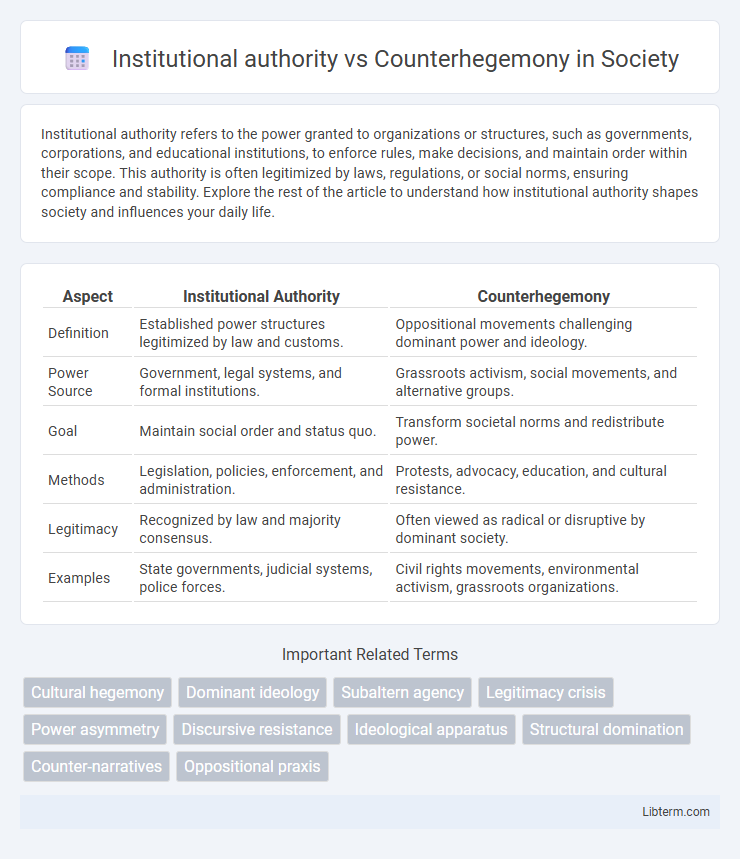Institutional authority refers to the power granted to organizations or structures, such as governments, corporations, and educational institutions, to enforce rules, make decisions, and maintain order within their scope. This authority is often legitimized by laws, regulations, or social norms, ensuring compliance and stability. Explore the rest of the article to understand how institutional authority shapes society and influences your daily life.
Table of Comparison
| Aspect | Institutional Authority | Counterhegemony |
|---|---|---|
| Definition | Established power structures legitimized by law and customs. | Oppositional movements challenging dominant power and ideology. |
| Power Source | Government, legal systems, and formal institutions. | Grassroots activism, social movements, and alternative groups. |
| Goal | Maintain social order and status quo. | Transform societal norms and redistribute power. |
| Methods | Legislation, policies, enforcement, and administration. | Protests, advocacy, education, and cultural resistance. |
| Legitimacy | Recognized by law and majority consensus. | Often viewed as radical or disruptive by dominant society. |
| Examples | State governments, judicial systems, police forces. | Civil rights movements, environmental activism, grassroots organizations. |
Defining Institutional Authority
Institutional authority refers to the legitimate power exercised by established organizations and governing bodies to enforce laws, norms, and policies within a society. This authority is typically recognized through legal frameworks, formal rules, and institutional structures such as governments, courts, and law enforcement agencies. These institutions maintain social order by establishing standardized procedures and decision-making processes that are widely accepted and legitimized by the populace.
Understanding Counterhegemony
Counterhegemony challenges institutional authority by contesting dominant ideologies and power structures that maintain societal control. It operates through grassroots movements, alternative discourses, and resistance practices aimed at deconstructing hegemonic norms enforced by state institutions and corporate elites. Understanding counterhegemony requires analyzing how marginalized groups mobilize cultural and political resources to disrupt and transform prevailing hegemonic frameworks.
Historical Contexts of Power Struggles
Institutional authority refers to established power structures legitimized by laws, traditions, and governance systems, often reinforcing dominant ideologies throughout history. Counterhegemony emerges as resistance movements and alternative narratives challenging these dominant powers, exemplified by anti-colonial struggles, civil rights activism, and labor movements during different historical epochs. Power struggles between institutional authority and counterhegemony reveal the dynamic processes through which hegemony is maintained, contested, or transformed within sociopolitical contexts.
Mechanisms of Institutional Control
Institutional authority maintains social order through mechanisms such as legal frameworks, bureaucratic governance, and standardized norms that legitimize power structures. Counterhegemony challenges these mechanisms by disrupting dominant narratives and promoting alternative ideologies via grassroots movements, cultural resistance, and critical activism. These opposing forces continually negotiate control over societal values, influencing legitimacy and power distribution in political and social systems.
Counterhegemony in Social Movements
Counterhegemony in social movements challenges established institutional authority by contesting dominant power structures and ideologies. These movements mobilize marginalized groups to create alternative narratives and practices that resist cultural and political norms upheld by institutions. Through direct action, grassroots organizing, and critical discourse, counterhegemonic efforts seek to redistribute power and promote social justice.
Media Influence: Authority vs Dissent
Institutional authority in media often reinforces dominant narratives by controlling information flow and shaping public opinion through established channels like mainstream news outlets and government communications. Counterhegemony employs alternative media platforms, social networks, and grassroots journalism to challenge official discourses, amplify marginalized voices, and promote dissenting viewpoints. Media influence thus becomes a battleground where authority sustains power structures while counterhegemony mobilizes resistance and democratizes information access.
Education Systems and Ideological Hegemony
Education systems serve as instruments of institutional authority by disseminating dominant ideological hegemony that reinforces existing social hierarchies and power structures. Counterhegemony challenges this by promoting alternative narratives and critical pedagogy aimed at exposing and dismantling dominant discourses within educational curricula. Critical theorists like Antonio Gramsci emphasize the role of education in both maintaining and contesting hegemonic power through the struggle over cultural and ideological control.
Digital Platforms as Counterhegemonic Spaces
Digital platforms disrupt traditional institutional authority by enabling decentralized information flows and grassroots mobilization, fostering counterhegemonic spaces where marginalized voices challenge dominant narratives. These platforms amplify alternative discourses through user-generated content, algorithmic dissemination, and networked communities, undermining centralized control and promoting participatory democracy. The dynamic interplay between corporate platform governance and user activism highlights the contested terrain of power and resistance in digital public spheres.
Case Studies: Institutional Authority Challenged
Case studies in institutional authority versus counterhegemony reveal how dominant power structures face organized opposition challenging their legitimacy and control, such as the anti-apartheid movement in South Africa and the Arab Spring uprisings. These movements utilize grassroots activism, social media mobilization, and alternative narratives to undermine state-sanctioned authority and promote social justice reforms. The dynamic interaction between institutional authority and counterhegemony highlights struggles over cultural, political, and ideological dominance within contested societies.
The Future of Counterhegemonic Actions
Institutional authority maintains power through established legal, political, and economic frameworks, while counterhegemony challenges these dominant structures by advocating alternative values and social orders. The future of counterhegemonic actions lies in leveraging digital activism, grassroots mobilization, and transnational networks to disrupt hegemonic narratives and create inclusive spaces for marginalized voices. Emerging technologies and decentralized platforms will amplify counterhegemonic strategies, fostering collaborative resistance that reshapes institutional power dynamics.
Institutional authority Infographic

 libterm.com
libterm.com